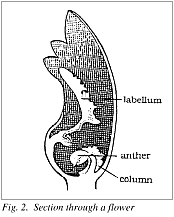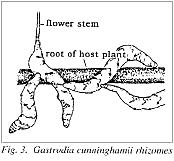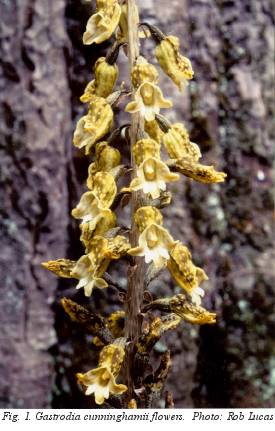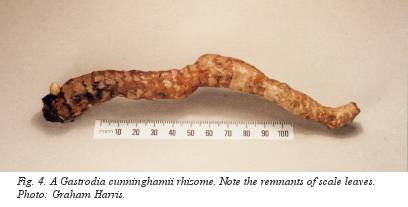
|
Huperei
— the Black Orchid
From The New Zealand
Garden Journal (Journal of the Royal New Zealand Institute of Horticulture),
Vol. 2, No. 3, September 1997, pp. 7-9.
Huperei or the black
orchid Gastrodia cunninghamii is a leafless orchid which
bears flowers from November to February. Fifty or more flowers are
borne on a single stem which can reach 1 metre in height. The flowers
have short stalks and are about 15 mm long. They are purplish brown
with mottled pale raised calluses on the outer surface and the inside
of the flowers varies from cream to white. The flowers are tubular
with 5 lobes and the labellum which is enclosed in the tube, is
much longer than the column which supports the anther. The scent
of the flowers has been described by some as unpleasant and by others
as sweet. The orchids store nutrients in starchy underground rhizomes
which may be up to 250 x 50mm. The rhizomes which lack roots have
obvious remnants of scale leaves. The rhizomes may be up to 600mm
below the soil surface. Occurrence and distribution Huperei is found throughout New Zealand in lowland forest and shrub land. Moore and Edgar 1970:158 record that it is "not uncommon in dark shaded places but easily overlooked.." They note that its range has not been fully recorded. The author has recorded numerous specimens growing in the Akatarawa valley near Upper Hutt. Most were found growing in deep shade near or in the vicinity of hard beech Nothofagus truncata however they were also found near Kahikatea Dacrycarpus dacrydioides and putaputaweta Carpodetus serratus in places where Nothofagus truncata was not present. A Symbiotic Association Huperei lacks leaves and chlorophyll and receives nutrients through a complex symbiotic association with a fungal pathogen (Armillaria novae-zealandiae), parasitic on the roots of a wide range of forest trees. This association is detailed by Campbell 1962. The summary to this paper records:
Armillaria mellea referred to by Campbell, is now classified as A. novae-zealandiae (Pennycook 1989:37) who refers to A. mellea as a European species not known in New Zealand. Although Gastrodia
cunninghamii appears to be most commonly found growing near
Nothofagus species it is also found growing where they
are absent. Moore and Edgar 1970:158 note that most specimens are
found in Nothofagus forest but that it also occurs on Mt
Egmont, the Chatham Islands and Stewart Island where Nothofagus
is absent. It appears that the plant is not confined to growing
in or in the vicinity of native forest or in deep shade. Given 1959:4
recorded Gastrodium cunninghamii "growing in alluvial
soil on the riverbank close to the trunks of willows. The nearest
native forest was some miles distant..." These plants were
growing near Takaka. Pennycook 1989:37 lists
a range of plants recorded as being hosts of Armillaria nova-zealandiae
including matsudana willow Salix matsudana. It is possible
that Gastrodia cunninghamii could have as many associations
as Armillaria nova-zealandiae, its host fungus. Significance to Maori  The
rhizomes of the huperei or perei were eaten by Maori
and were regarded as a delicacy. They are described in Riley 1994:332
as being not unlike small kumaras, with a slightly sweet taste. They
were cooked in a hangi or roasted in the embers. Colenso
1880:31 noted that the rhizomes were eaten but that they were scarce
and only found in dense forest. Similar information is provided by
Tregear 1926:99 in writing about traditional food sources of the Maori.
He also describes the rhizomes as resembling a long red radish root.
He agreed with Colenso that the root was valued, scarce and only found
in dense forests. Hammond 1894:238 describes perei as like
the taro in colour but the kumara in shape and that
the tubers were from three to eight inches in length. He noted that
the plant was quite common before the introduction of pigs. The
rhizomes of the huperei or perei were eaten by Maori
and were regarded as a delicacy. They are described in Riley 1994:332
as being not unlike small kumaras, with a slightly sweet taste. They
were cooked in a hangi or roasted in the embers. Colenso
1880:31 noted that the rhizomes were eaten but that they were scarce
and only found in dense forest. Similar information is provided by
Tregear 1926:99 in writing about traditional food sources of the Maori.
He also describes the rhizomes as resembling a long red radish root.
He agreed with Colenso that the root was valued, scarce and only found
in dense forests. Hammond 1894:238 describes perei as like
the taro in colour but the kumara in shape and that
the tubers were from three to eight inches in length. He noted that
the plant was quite common before the introduction of pigs. There
appears to be no references to medicinal properties of the plant,
however Colenso 1868:261 referred to the roots as containing "salep"
which is described as a food or drug prepared from dried orchis roots
(Grieve 1995:1). A related plant, Gastrodia elata from China
contains gastrodin which has sedative, hypnotic and antispasmodic
properties. There
appears to be no references to medicinal properties of the plant,
however Colenso 1868:261 referred to the roots as containing "salep"
which is described as a food or drug prepared from dried orchis roots
(Grieve 1995:1). A related plant, Gastrodia elata from China
contains gastrodin which has sedative, hypnotic and antispasmodic
properties.Maori must have gone to considerable effort to obtain huperei rhizomes as they were often found up to 600mm below the soil surface amongst tree roots in compacted soil. Campbell 1962:289-290 describes the difficulty in excavating rhizomes from beech forest in Fiordland and from mixed rain forest in South Westland. She recorded that many attempts to excavate rhizomes failed due to the compact nature of the soil and the very brittle rhizomes which were interwoven with a mass of tree roots.
According to Maori tradition the huperei or perei was not a plant of the earth but a creature of supernatural beings (Riley 1994:332) and there were many superstitions relating to it. The plant was supposed to understand the Maori language, so those who went to dig the rhizomes used the substitute name maukuuku to ensure that the huperei did not hear its name and disappear. Huperei was also known as uhiperei while the rhizomes were referred to as para or paratawhiti (Beever 1991:17). Acknowledgement The author acknowledges the technical advice and the photograph provided by Rob Lucas.References
Web-notes:
Some Orchid Links:
|
Home | Journal
| Newsletter | Conferences
Awards | Join
RNZIH | RNZIH Directory | Links
© 2000–2025 Royal New Zealand Institute of Horticulture
Last updated: July 11, 2008

 Reproduced
from an article by the late Graham Harris
Reproduced
from an article by the late Graham Harris